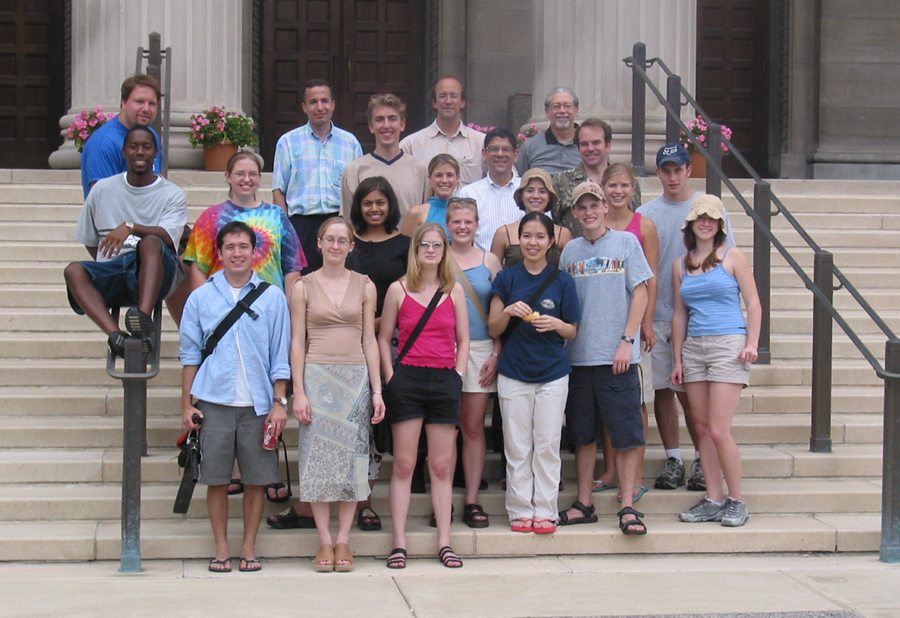
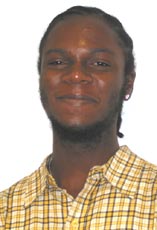
Home Institution: Florida A&M
Major/Minor: Physics
MRSEC Mentor: Kakalios
The Electrical and Optical Properties of Thin Film Hydrogenated Amorphous Silicon
A study will be performed on the electrical and optical properties of thin film hydrogenated amorphous silicon as a function of film composition and doping level. The dark conductance and photo conductance of these samples will be studied for varying temperatures and light intensities. In this way the material’s activation energy in the dark and as a function of light exposure will be reported. This information will be relevant for other studies of amorphous hydrogenated silicon, including studies in 1/f noise and the Staebler-Wronski effect. In particular, we will investigate compensated amorphous silicon films (that is a-Si:H doped with both phosphorus and boron), which display a persistent photoconductivity effect, where the dark conductivity of the film increases following a brief light exposure.

Home Institution: Penn State Hazleton
Major/Minor: Mathematics
MRSEC Mentor: Ward
Designer Co-crystals for New and Improved Pharmaceutical Foundations
Pharmaceutical products typically are brought to market through a process that involves design, discovery, evaluation of toxicology, and optimization of formulations - consisting of the active compound and any excipients - for bioavailability. Even though creative strategies have been developed for the optimization of crystalline small molecule drugs, pharmaceutical development often relies on empirical identification of possible active compounds. This procedure is followed by a search for any polymorphs of the compounds and evaluation of their physical properties, such as particle size, crystallinity, filterability, solid flow characteristics, melting point, relative stability, and solubility. The crystallization and properties of small molecule pharmaceuticals are increasingly being recognized as fundamental materials issues. Our goal is to demonstrate that properties such as melting point and other mechanical properties can be improved through the formation of co-crystals. This can be accomplished by the co-crystallization of a pharmaceutically active compound “A” and inert secondary component “B” through solid-phase processing or solution crystallization. Often, low melting points and poor mechanical properties of pharmaceutically active compounds can be attributed to an absence of self-complementary hydrogen bonding; in many cases the active compounds have either hydrogen bond donor or acceptor substituents, but not both. During solid-phase processing, such compounds can melt and recrystallize to less desirable polymorphs, or undergo phase transitions to new forms directly. We will choose compounds that promise to have stronger hydrogen bonding with A than A can achieve with itself, enhancing the crystal lattice energy so that the melting temperature and/or phase stability will increase. Powder x-ray diffraction, infrared spectroscopy, crystal growth, and atomic force microscopy will be used to identify newly formed co-crystals.
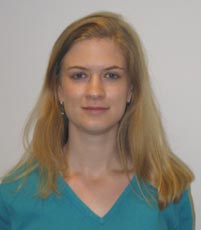
Home Institution: Northwestern U
Major/Minor: Chemical Engineering
MRSEC Mentor: Tranquillo
Assessing Changes in SMC Phenotype in Media-Equivalents Subjected to Cyclic Mechanical Loading
Tissue engineering offers the ability to create artificial tissues or organs that can ultimately be used in transplants. The goal of this project is to develop a functional bioartificial artery. The current model being tested is a media equivalent (ME) named because it imitates the media layer of an artery. The ME should have similar properties to a native artery and this project tries to characterize some of those properties. This research focuses on assessing whether there are changes in the smooth muscle cell (SMC) phenotype after the ME has been mechanically conditioned. The ME is also tested for contractile responses to different drugs.

Home Institution: Gustavus Adolphus
Major/Minor: Physics & Music
MRSEC Mentor: Crowell
Spin Transport in Ferromagnetic-Semiconducting Heterostructures
We will characterize the use of optical detection of spin transport across ferromagnet-semiconductor Schottky diode heterostructures. Spin transport is thought to be accomplished via tunneling of spin-polarized electrons across the Schottky barrier into a semiconducting diode due to an applied electric field. Injected carriers radiatively recombine in a GaAs quantum well (QW) embedded in the depletion region of an Al1-xGaxAs p-i-n diode. Due to the selection rules of zinc-blend semiconductors, the polarization of photons emitted is correlated with the spin of the recombining electron. Both optical pumping and applied magnetic field are used to induce spin polarization and both photoluminescence and electroluminescence (respectively) are used to detect the injected electron spin-polarization in the semiconductor. By observing the luminescence as a function of applied magnetic field, electric field, excitation wavelength, and detection geometries, optical detection will be systematically analyzed as a method for observing spin transport.
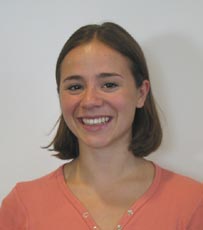
Home Institution: U of Florida
Major/Minor: Chemical Engineering & Chemistry
MRSEC Mentor: Hillmyer
Influence of the Octene Content on the Properties of Poly (lactic Acid)/Linear Low-Density Polyethylene Binary Blends
Poly (lactic acid) (PLA) is a biodegradable polymer synthesized from lactic acid, which is derived from renewable resources such as corn and sugar beets. It currently has several commercial applications, mainly in the biomedical field, and in the future could be used to replace many petroleum-based polymers. While PLA is a stiff polymer, it is also brittle which could limit its commercial utilization. In an effort to toughen poly (lactic acid) without compromising its stiffness, PLLA (semi-crystalline PLA) will be melt blended with linear low-density polyethylene (LLDPE). The goal of the research is to determine the effect of the LLDPE octene content on the PLA/LLDPE blends. Three linear low-density polyethylene’s (with 17, 38 and 45 weight percent of octene) will each be melt blended with PLLA into binary blends (80% PLLA). The blends will undergo tensile testing and impact testing to determine the tensile modulus and the toughness of each blend. The aim is to obtain an increase in toughness without decreasing the modulus. Because other factors such as the LLDPE particle size and the adhesion between the two polymers can affect the toughness of the material, tests must be run in order to assess these parameters. Adhesion testing will reveal the adhesion between the PLLA and the LLDPE in each blend. Light scattering as well as SEM will determine if the particle sizes within each blend are similar. A rheometer will be used to determine the viscosities of the polyethylenes. A difference in viscosities may correlate to a difference in particle size, thus affecting the properties of the PLLA/LLDPE blends. The LLDPE will also be characterized by differential scanning calorimetry to determine the percent crystallinity of the material as well as by tensile testing to determine the homopolymer mechanical properties. From this research, the effect of the octene content in the LLDPE on the binary blend properties will be determined.
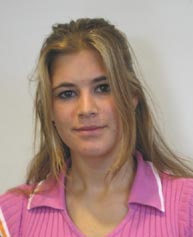
Home Institution: Penn State
Major/Minor: Materials Science
MRSEC Mentor: Ward
Synthesis of Asymmetric Pillars to Construct Polar Network Lattices
Recently the Ward Group has reported a series of crystalline inclusion compounds based on lamellar host frameworks constructed from a guanidinium cation (G) and various organodisulfonate anions (S). These GS compounds form three-dimensional networks in which the G and S ions form a robust yet flexible 2-D sheet that are connected by the organic residue of the disulfonate anion. It has previously been shown that polar guests molecules will align themselves to achieve macroscopic polar ordering in an inherently non-polar GS lattice. Asymmetric pillars, which comprise part of the host lattice, can be created through organic synthesis to engineer polar host/guest structures. These polar crystals are of interest due to their interesting non-linear optical (NLO) properties such as second harmonic generation (SHG) and two-photon mixing. A series of asymmetric biphenyl "pillars" can be synthesized via Suzuki coupling reactions. These reactions involve the selective coupling of substituted 4-aminobromobenzenes to substituted 4-aminophenylboronic acids. Each half of the coupling partners may have either donor or acceptor groups. When on opposite ends of the organic portion of the disulfonate pillar they create a pillar with a dipole moment. Other methods are being investigated to create these pillars such as creating boronic acids, which will be used to synthesize pillars with an electron-donating group and a proton-withdrawing group.

Home Institution: MIT
Major/Minor: Chemical Engineering & Biomedical Engineering
MRSEC Mentor: Barocas
Transient Orientational and Mechanical Behavior of Collagen Gels: Poroelasticity vs. Viscoelasticity
Tissues and tissue equivalents (artificial or model tissues made from fibrous protein gels) function on the millimeter to centimeter length scale, but their mechanical behavior is governed by a fibrous matrix whose characteristic length scale is on the order of a micron. My research is focused on better understanding the role of microstructure and microstructural rearrangement in determining the macroscopic properties of such material, with the emphasis on collagen-based tissue equivalents. {because of their ease of use and their importance in tissue engineering} I am interested in exploring two different mechanical relaxation processes that can occur within a collagen gel. By relaxation, meaning that if you impose a deformation on the gel (e.g., you squeeze it), the gel will generate a stress resisting the deformation. If you wait around, that stress will dissipate or “relax” over time. There are two different mechanisms by which this relaxation can occur. In poroelastic relaxation, the network doesn’t much mind being compressed, but the water in the network does, and it takes finite time for the water to permeate out of the network. In viscoelastic relaxation, however, the network itself slowly dissipates stress either by Brownian motion or by interfiber friction (which we believe is the major player here) One can separate poroelastic from viscoelastic effects by changing the sample size. Large samples are much more sensitive to poroelastic effects because the water has to permeate farther to get out of the sample. Thus, by performing a series of experiments on samples of different sizes, I will be able to separate the two effects. These results become really interesting when I start looking at fiber rearrangement. The fibers in the network rearrange when the sample is deformed. It appears that when the sample exhibits viscoelastic relaxation, the orientation does not – the fibers remain in the orientation pattern set by the initial deformation. What happens in poroelastic relaxation is unknown, but it is thought that there will be some re-arrangement back toward the orientation of the unreformed state: UNDEFORMED à leads to DEFORMATION à stress goes up, orientation changes After some TIME à Stress goes away, orientation stays in new configuration I will be working with the instron machine, which can measure stress and orientation simultaneously. I will perform experiments on the instron machine and assess the different effects.

Home Institution: Gustavus Adolphus
Major/Minor: Physics
MRSEC Mentor: Kakalios
The Electrical and Optical Properties of Thin Film Hydrogenated Amorphous Silicon
A study will be performed on the electrical and optical properties of thin film hydrogenated amorphous silicon as a function of film composition and doping level. The dark conductance and photo conductance of these samples will be studied for varying temperatures and light intensities. In this way the material’s activation energy in the dark and as a function of light exposure will be reported. This information will be relevant for other studies of amorphous hydrogenated silicon, including studies in 1/f noise and the Staebler-Wronski effect. In particular, we will investigate compensated amorphous silicon films (that is a-Si:H doped with both phosphorus and boron), which display a persistent photoconductivity effect, where the dark conductivity of the film increases following a brief light exposure.
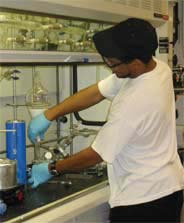
Home Institution: Florida A&M
Major/Minor: Chemistry
MRSEC Mentor: Bates
Phase Behavior of Poly (isoprene-b-styrene-b-ethylene oxide) Copolymers
In polymers, morphology can be one of the main properties that determines its functionality. We will be studying the morphology of poly (isoprene-b-styrene-b-ethylene oxide) as a function of its volume fractions. We will be looking at this relationship in an effort to synthesize a permeable membrane that is more efficient than the membranes currently used in fuel cells. To synthesize the polymers with the volume fractions we desire, we will be using anionic synthesis. To analyze the morphological properties of poly (isoprene-b-styrene-b-ethylene oxide) we will be using small angle x-ray scattering (SAXS), and transmission electron microscopy (TEM).

Home Institution: UW-River Falls
Major/Minor: Chemistry
MRSEC Mentor: Tranquillo
Photopolymerization of PEG Hydrogels for Drug Delivery Systems
In peripheral nerve damage when the distance from the proximal to the distal ends of the neuron are greater than one millimeter, the chances of nerve regeneration are very low. Bob Tranquillo, et al. have already developed a method to encourage neuron growth. This method involves a magnetically aligned collagen or fibrin tube that is connected between the proximal and distal ends of the neuron. This method has been shown to guide nerve fiber growth through a gap up to 6 mm. To further improve regeneration, nerve growth factor (NGF) is needed at the tip of the growing axon. NGF is an expensive molecule and it can diffuse out of the entubulation, so a smart release system is needed. We propose to develop a method of making a hydrogel that will contain nerve growth factor (either through chemical cross linking or physical containment in a microsphere) and that is capable of releasing NGF at the tip of the growing axon. So far, cross linked networks of poly (ethylene glycol) diacrylate, or PEG-DA, have been achieved through photopolymerization both with and without a photoinitiator. Upon photoinitiation with 2,2-dimethoxy-2-phenyl acetophenone, the cross linking occurred rapidly, taking less than 3 minutes to complete. Without photoinitiation, cross linking took more than an hour to complete. A possible problem of using the photoinitiator is the adverse effect on NGF. It has been shown that 2,2-dimethoxy-2-phenyl acetophenone has an adverse effect on myoglobin, a protein that is smaller than NGF. The problem of photopolymerization without the photoinitiator is the length of time the protein is exposed to the long wave UV light.
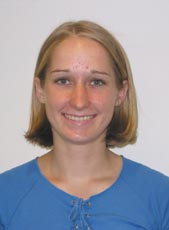
Home Institution: South Dakota School of Mines and Technology
Major/Minor: Chemical Engineering
MRSEC Mentor: Lodge
Glass Transition in Miscible Mixtures
The viscosity of a glass mixture depends on the glass transition temperature (Tg) making it an important parameter. The glass transition temperature is the temperature at which the substance changes abruptly from the glassy state to a rubbery state. Differential scanning calorimetetry (DSC) measures the energy required to maintain a zero temperature difference between a sample pan and standard (blank) as they are brought through the specified temperature change. From this data, Tg as a function of composition is computed along with the transition width. The Tg of polymer blends shows broadening because of each component’s different local composition. Factors contributing to local composition include “self concentration” effects brought about by chain connectivity. By looking at mixtures of polymeric and small molecule glass formers, effects of chain connectivity on “self concentration” will be noticeable. Furthermore, changing the polymer-solvent interaction parameter (c) affects local composition. Therefore, by varying the chain connectivity and the polymer-solvent interaction parameter, the study of the effects of local composition is possible. Using small molecule glass formers eliminates chain connectivity effects with both of the components.
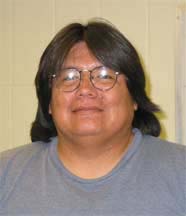
Home Institution: Sitting Bull College
Major/Minor: Chemical Engineering
MRSEC Mentor: McKernan
Evaluate different thin films thickness using different techniques
To use different analytical techniques such Ion Beam Analysis (IBA), Rutherford Backscattering Spectrometry (RBS), Scanning Electron Microscope (SEM), Profilometer, Spectroscopic Elipsometer, Fourier Transform Infared Spectrometer (FTIR), to evaluate different parameters of film thickness. To understand the different principles on thin films using important parameters such as; Ion Scattering Angle/Sample Tilt Angle, Kinematic factor, Scattering Cross section, Analysis Depth, Radiation Damage

Home Institution: UMN
Major/Minor: Chemical & Electrical Engineering, Chemistry
MRSEC Mentor: Frisbie
Electrical and Morphological Characterization of Novel Organic Semiconductors
The desire for inexpensive, flexible, and easily fabricated electronics has led to considerable interest in the use of organic molecules as semiconductors. Compounds such as pentacene and sexithiophene have received much attention in this field of study due to their promising electrical properties and desirable morphology, but newly engineered molecules have only recently approached the necessary mobility requirements for commercial electronics. Using the Thin Film Transistor (TFT) arrangement, the carrier mobility and electrical properties of novel organic molecules will be studied. The morphological properties of these materials will also be studied by Atomic Force Microscopy (AFM).
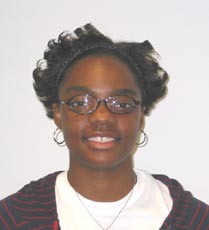
Home Institution: Florida A&M
Major/Minor: Chemistry & Molecular Biology
MRSEC Mentor: Stadler
Nanopore Formation on Semiconductors and Isulators Using Anodic Oxide Aluminum
no abstract available

Home Institution: Florida A&M
Major/Minor: Pharmacy
MRSEC Mentor: Ward
Designer Co-crystals for New and Improved Pharmaceutical Foundations
Pharmaceutical products typically are brought to market through a process that involves design, discovery, evaluation of toxicology, and optimization of formulations - consisting of the active compound and any excipients - for bioavailability. Even though creative strategies have been developed for the optimization of crystalline small molecule drugs, pharmaceutical development often relies on empirical identification of possible active compounds. This procedure is followed by a search for any polymorphs of the compounds and evaluation of their physical properties, such as particle size, crystallinity, filterability, solid flow characteristics, melting point, relative stability, and solubility. The crystallization and properties of small molecule pharmaceuticals are increasingly being recognized as fundamental materials issues. Our goal is to demonstrate that properties such as melting point and other mechanical properties can be improved through the formation of co-crystals. This can be accomplished by the co-crystallization of a pharmaceutically active compound “A” and inert secondary component “B” through solid-phase processing or solution crystallization. Often, low melting points and poor mechanical properties of pharmaceutically active compounds can be attributed to an absence of self-complementary hydrogen bonding; in many cases the active compounds have either hydrogen bond donor or acceptor substituents, but not both. During solid-phase processing, such compounds can melt and recrystallize to less desirable polymorphs, or undergo phase transitions to new forms directly. We will choose compounds that promise to have stronger hydrogen bonding with A than A can achieve with itself, enhancing the crystal lattice energy so that the melting temperature and/or phase stability will increase. Powder x-ray diffraction, infrared spectroscopy, crystal growth, and atomic force microscopy will be used to identify newly formed co-crystals.

Home Institution: Pomona Col.
Major/Minor: Physics & Economy & Math
MRSEC Mentor: Dahlberg
Micro-Machining Strontium Titanate Dielectric Films of 1-10 Micron Thicknesses From Single Crystal Starting Material
In undertaking this project, we set out to micro-machine Strontium Titanate (STO) substrates. We have chosen STO for its characteristically high dielectric constant. Motivated by the prospect of micron-level devices with extremely high capacitances, we will eventually grow Moly-Germanium films (epitaxially compatible with STO) and Platinum gates to sandwich our STO dielectrics. With this future plan in mind, out primary goal is to achieve thicknesses of 1-10 microns. We begin our process with single crystal samples of STO having thicknesses of 500 microns. Through a combination of diamond slurry lapping (thanks to the generous assistance of Advanced Research Corporation), Ar ion milling, and minor touch-ups with HF, we hope to obtain thicknesses on the order of a single micron. We predict further testing to reveal larger capacitances than in our thicker samples.
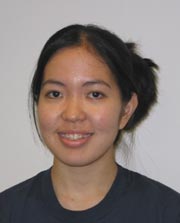
Home Institution: Washington State
Major/Minor: Chemical Engineering & Materials Science
MRSEC Mentor: Macosko
Effects of Functional Polymer Composition on the Adhesion of Thermoplastic Urethanes and Polypropylene Blends
The advantages of polymer blends have been well known and many studies have been conducted for the development of such blends. Not only do the blends often combine desired properties of two or more polymers, but it also reduces the overall cost by incorporating less expensive material to form a product with properties comparable to more expensive polymers. In general, it is easier to blend polymers with known properties and investigate the resulting product rather than to create a new polymer entirely isolated. Although polymer blends exhibit many advantages, the problem that is often encountered in polymer blends is that fact that many blends are immiscible. The blends of thermoplastic urethanes (TPU) and polypropylene (PP) exhibit this problem and are under the current study. When blended appropriately, these two polymers combined show-advanced properties than the individual polymers alone. To counteract this problem, compatibilizers are utilized in certain forms. Such a form is a so-called functional polymer that is introduced into the normally immiscible blend. This functional polymer has one end miscible in one polymer with the opposite end miscible in the other polymer, therefore, locking the two polymers at the interphases. It is proposed to study three different types of functional polymers: polypropylene grafted malignant anhydride (PP-g-MA), polypropylene grafted primary amine (PP-g-NH2), and polypropylene grafted secondary amine (PP-g-NHR) PP and the three different functional polymers will be blended at different compositions, laminas of the blends will be made, and annealed to a TPU lamina. An adhesion test proposed by Boucher, et al would then be conducted to investigate the effects of the functional polymer composition on the adhesion between the two annealed laminas.

Home Institution: UMN
Major/Minor: Chemical Engineering & Chemistry
MRSEC Mentor: Barocas
Compaction and Viability of Cryoinjured AT-1 Cellular Tissue Equivalents
Cryosurgery is an increasingly attractive alternative to a prostatectomy or radiation therapy for the treatment of prostate tumors. While promising, the mechanisms by which it kills tumor cells and tissue are not well understood. To characterize further the effects of cryosurgery, tissue equivalents (TEs) are used to simulate prostate tumor tissue. TEs are collagen constructs seeded with AT-1 rat prostate tumor cells. Shortly after the TEs gel they are separated from the petri dish and allowed to float. Over the next few hours the cells embedded within the collagen extracellular matrix attach themselves to the collagen fibers, exerting a sustained cell traction force. This cell traction force is observed through the decreasing diameter and thickness of the tissue equivalent, referred to as compaction. Cryosurgery is performed on three-day-old tissue equivalents using a cryoprobe inserted into the center of the TE. The cryoprobe is cooled to –80 °C and held at that temperature for ten minutes. The cryoprobe uses compressed argon gas regulated by a CRYOcareä machine. Thermocouples are used to monitor the temperature at various points in the TE before, during, and after the freeze to obtain a thermal history. The selected freezing hold time allows a ring of uninjured tissue to remain outside the iceball. Immediately after the injury a digital picture of the TE next to a ruler is taken. Digital pictures are taken immediately after the passive thaw and every three hours for the following three days. Thereafter a picture is taken twice per day until one week has passed since the injury. The pictures are analyzed using imaging software to measure the diameter of the injured region and the TE. It is expected that there will be further compaction after the injury but the rate of this compaction is unknown. Live/dead stains will be used to confirm that the cells close to the injury site are dead and to quantify cell viability as a function of radial position. By combining the thermal history, compaction, and viability data, we will gain greater understanding of the cryoinjury process.

Home Institution: Sitting Bull College
Major/Minor: Natural Science
MRSEC Mentor: Wang
Microscopy and Film Thickness/Density
This year at the Materials Research Science and Engineering Center (MRSEC) I have the opportunity to work with some of the best professors and students from around the country. The mentors I will be working with are Yongquiang Wang Ph.D. and Stuart McKernan Ph.D. I will be studying microscopy with Dr. Mckernan. Microscopy is the study of microscopes, and I will have the opportunity of working with the Environmental Scanning Electron Microscope (ESEM). I will also be working with another microscope named the Video Enhanced Microscope (VEM). With these microscopes I will be studying specimens, which will be posted on the University of Minnesota Characterization Facility (Char Fac) web site. The specimens that will be featured will be yellow jackets, raw sour dough, sugar crystals, and sand, which may not sound like much but when magnified one thousand times or more, there actual size become very different to look at then with the naked eye. With Dr. Wang I will be studying film thickness using many different techniques such as the Ion Beam Analysis, Rutherford Backscattering Spectrometry (RBS), and also the Ipsometer. Although these techniques have evolved over the years, they still are not perfected, which makes this type of research very exciting. We will be using silicon and kapton coated with a platinum film. The platinum film may be revolutionary when coated on kapton, due to the fact that it has not been extensively researched, and when kapton is put under the IBA there has been a significant problem with out gassing, meaning that the hydrogen content does not stay stable. The theory that Dr. Wang has recognized is that if coated with the right amount of platinum film this problem may eventually be solved.

Home Institution: Worcester Polytechnic
Major/Minor: Biomedical Engineering & Organizational Leadership
MRSEC Mentor: McCormick
Interactions Between Surfactants and the Protein Casein
Surfactants (or surface-active agents) are substances that when presented to a system in low concentrations have the capability to adsorb onto surfaces or interfaces and change the free energies of those surfaces. An equally fundamental property of surfactants is their ability to form micelles, or colloidal-sized clusters in solution. The most unique phenomenon associated with micelle formation is the point of critical micelle concentration. This is the concentration at which the size limit of the micelles has been reached and the surface tension of the interface ceases to decrease sharply. The surface tension will almost become constant after this point. Surfactant micelles, due to their hydrophobic tails and their hydrophilic heads easily trap dirt and oils inside of them and therefore make good detergents. Surfactant-protein systems have a myriad of applications. For example, surfactants are used to remove blood proteins from reused medical devices, clean household appliances, as well as maintain the integrity of food equipment such as milk storage containers. The particular focus of this research project is to investigate how surfactants interact with the proteins. Currently, the predictability of the extent of removal of an adsorbed protein for a specific surfactant is poor. We are looking to better understand the molecular interactions between proteins and surfactants in order to improve surfactants for household and commercial use. Our proposed method in attacking this problem is to study the interaction between the protein casein, found in milk, and various surfactants. We are currently unsure of which surfactants we will be using but will know as soon as a correspondence with Ecolab has been completed. Casein is a very complex protein due to its lack of crystallinity and poorly defined 3-D structures. However, it does remain stable in water environments and we want to specifically target the dairy protein problems. We are also currently unsure as to which concentrations to use for both the surfactants and proteins in the experiments in order to acquire the best series of results. Although, we have obtained previous experiments that will hopefully guide us in the right direction as soon as we determine which surfactants we will be using. Once we determine the proper concentrations of our substances, we will look at some or all of the following in order to better understand the molecular interactions. Measurements will be taken of the surface tension through one of the following methods: Wilhelmy plate, DuNouy ring, or the Spinning drop tensiometer. Surface pressure may also be looked at via the Langmuir trough. We will almost certainly use a Brewster angle microscope to visually investigate interfacial films. Surface rheology will be investigated in terms of dilatational rheology and functional properties such as foam stability by way of a dynamic drop tensiometer. Lastly, neutron reflectivity may be used to determine interfacial structure. It is our hope that these proposed methods would produce results that will enable us to analyze, at molecular level, how proteins bind to surfactants. If successful, new information will be available to improve numerous household, industrial, and biological problems.
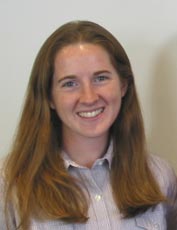

Home Institution: Augsburg College
MRSEC Mentor: Dan Dahlberg
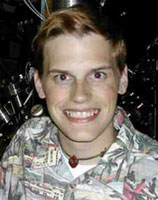

Home Institution: University of Wisconsin, Eau Claire
MRSEC Mentor: Palmstrom
Scanning Tunneling Microscopy Studies of Co, Fe, and Er on GaAs
Interfacial reactions between metals, such as Co and Fe, and GaAs have been studied over the years by x-ray photoelectron spectroscopy (XPS), reflective high-energy electron diffraction (RHEED) and auger photoelectron spectroscopy. These studies have included reaction studies, where the temperature dependence of the reaction is studied, and coverage studies, where different amounts of metals are deposited onto the surface of the substrate, and the structure of the overlying metal is studied. Our study is a continuation of these efforts and will concentrate on the first 40 monolayers (ML) of material deposited, thus gaining insight into the interfacial region between the magnetic overlayer (Co, Fe) and the underlying semiconductor (GaAs). These layers have become very important in the formation of tunneling barriers between ferromagnetic thin films and semiconductors. The barriers are critical to select the type of tunneling occurring across their structure and the threshold for turning quantum tunneling on and off. The performance of such magnetic heterostructures, or spintronic devices, depends critically on the properties of the interface layer between the magnetic/nonmagnetic thin films and the substrates. These layered thin film structures can be grown by molecular beam epitaxy (MBE) with a variety of different compositions, thus creating different surface recontructions and, hence, different tunneling characteristics.
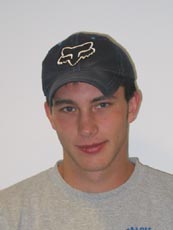
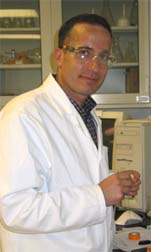
Home Institution: Penn State, Hazleton
MRSEC Mentor: Frisbie
Synthesis, Purification, and Crystallization of Pentacene Type Molecules
The purpose of my summer’s research is to develop procedures for synthesis, purification, and crystallization of five-ring pentacene like molecules. My goal is to be able to purify these compounds to the point where they will then can be used in high mobility semi-conductor applications. Currently, my main focus is on the purification of the compound Triphenodithiazine (TPDT). Figure 1 to the left represents the molecular structure of TPDT. In its purest form, TPDT is a dark violet crystal which has been referred to as having both “n-type” and “p-type” semi-conducting properties. Through selective synthesis and design of compounds, which will eventually act as organic wires, these thin film crystals have the potential to revolutionize the world of opto-electronics (waveguides, photoconduction, and solar energy conversion), electro-optics (non-linear optical and LED devices), and micro-electronics such as FET devices. TPDT has been synthesized in two general ways, yet a complete procedure on purification and crystallization to a point where it can be commercially used as a high mobility semi-conductor has not yet been presented to the science and engineering society. Having the X-ray crystal structure for TPDT, we know it is a planar molecule, which will π-stack, hence giving hope for using this molecule as a FET. Through using techniques and instruments such as TLC, DSC, NMR, IR and UV-Vis spectroscopy, I will be able to better identify impurities in the crude product and formulate ways to obtain these targeted molecules.
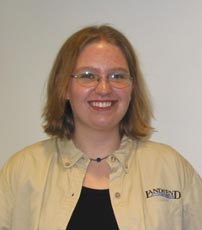
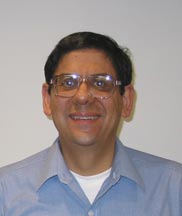
Home Institution: Northwestern College
MRSEC Mentor: Dahlberg
AC Magnetic Susceptibility of Biased Cobalt/Cobalt Oxide Bilayers
Meiklejohn and Bean [1] observed that Cobalt particles coated with Cobalt Oxide and then cooled in an external magnetic field show a preferential alignment of the sample magnetization along a single direction. This phenomenon is called the Ferromagnetic/Antiferromagnetic Exchange Bias Effect or the Exchange Anisotropy Effect. The theoretical basis for this effect, once developed, may lead to improved magnetic sensors and computer memory devices. In our work we are studying thin films consisting of a layer of Cobalt (typically 19 nm to 33 nm thick) combined with a layer of Cobalt Oxide (typically 100 nm thick). Magnetic susceptibility measures how easily a sample is affected by a magnetic field. In earlier work [2], the AC (alternating current) magnetic susceptibility of Co/CoO films was measured in the absence of an external magnetic field. In research done last year at the University of Minnesota, one of the authors (STR) measured the magnetic susceptibility of vertical-exchange-biased Co/CoO thin films as a function of horizontal magnetic field strength. This summer we propose to continue this work and develop our understanding of the observed behavior.


Home Institution: University of St. Thomas
MRSEC Mentor: Frisbie
G - DNA Field Effect Transistor
Deoxyribonucleic acid (DNA) is a double stranded molecule based on the Watson-Crick model. It can form a variety of conformations based on the sequences of the four nucleic acids that make up this molecule [1]. The different conformations that DNA can form has recently allowed demonstration of charge transport properties [2]. G4-DNA also known as G-wire may also do this. G4-DNA is a parallel stranded, quadruple helical DNA structure composed of guanine bases hydrogen bonded into a roughly planar quartet of bases [1]. It is guanine that is crucial for the conductivity of DNA as molecular dynamic calculations indicate that guanine may functions as a charge transporter [3]. However, this has yet to be proven experimentally. We will attempt to measure the conductive properties of G4-DNA by using them to construct a field effect transmitter with G4-DNA functioning as hole transporter. Atomic Force Microscopy (AFM) will be used to analyze the silicon dioxide substrate for G4-DNA which will be absorbed into the substrate. Once the substrate is covered with G4-DNA, gold electrode contacts will be evaporated onto the sample using a shadow mask technique.
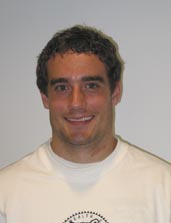
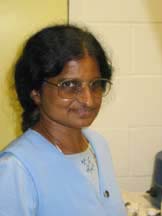
Home Institution: Penn State, Hazleton
MRSEC Mentor: Norris
Templated Growth of Planar Synthetic Opals
The goal of this summer project is to produce photonic crystals. Photonic crystals, by definition, are made of two materials of different refractive index. The material alternates periodically within the 2-dimensional or 3-dimensional structure, giving it the ability to reflect light for any direction of propagation in specific wavelength ranges, which could lead to the creation of all-optical integrated circuits. The objective is to produce photonic crystals made of silicon and air bubbles. A template directed approach will be used for making the photonic crystal. This approach involves the self-assembly of monodisperse colloidal silica spheres onto a silicon wafer. The spheres must organize in a face centered cubic (f.c.c.) lattice. The bulk of research will entail determining the optimum conditions to develop a face centered cubic lattice of silica spheres. Once this goal is accomplished, the interstitial space will be filled with silicon within the f.c.c. structure and the silica template will be removed by wet etching. Thus the thin planar inverted opal or photonic crystal will have been formed.

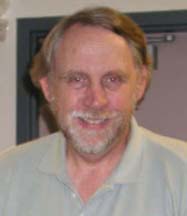
Home Institution: Harvey Mudd College
MRSEC Mentor: Dahlberg
Inhibited Exchange in Cobalt - Silver - Cobalt Oxide Thin-Film Systems
When cobalt and cobalt oxide, a ferromagnetic and an antiferromagnet, respectively, are layered on top of one another, an exchange bias arises in the magnetization of the sample. A training effect also arises as the sample is taken through the range of magnetic fields repeatedly, reducing the exchange and coercive fields. This research investigates the impact of silver between cobalt and cobalt oxide on these effects.
UMN MRSEC
435 Amundson Hall, 421 Washington Ave. SE, Minneapolis, MN, 55455
P: 612-626-0713 | F: 612-626-7805